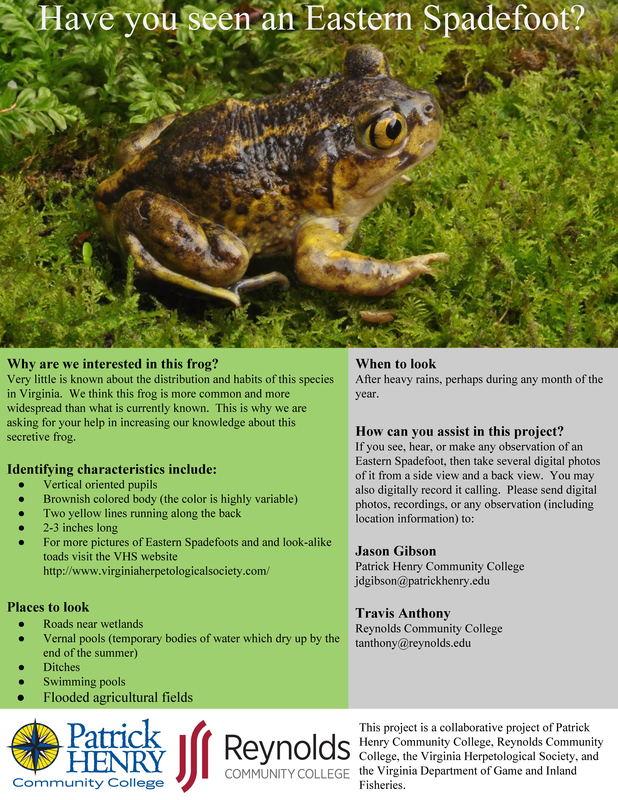
Article submitted by Jason Gibson, Patrick Henry Community College
Faculty at two community colleges are collaborating with the Virginia Herpetological Society (VHS) and the Virginia Department of Game and Inland Fisheries to get citizens all around the state to contribute observations they make on the Eastern Spadefoot (Scaphiopus holbrookii). Very little is known about the Eastern Spadefoot in Virginia, due to it secretive nature. It is believed that this frog is much more common and occurs in many more locations than what is currently known. In order to get citizens all over Virginia looking for this frog, they have created a wanted poster. It is their hope to fill in distribution gaps and perhaps gather some basic phenological data on this species. It is also their hope to evaluate how effective a wanted poster is in getting citizens to contribute information about specific species.
The Eastern Spadefoot is recognizable by its vertically-oriented pupils and the two yellow lines running along its back. Up close, you might also note the "spade", a black projection on the foot that is used for digging; this species spends much of its time underground. Its call is a short, low-pitched "waaaah" that some liken to the sound of a crow. Learn more about the Eastern Spadefoot and listen to its call on the VHS website.
Virginia Master Naturalists should keep eyes and ears out for Eastern Spadefoots, especially after heavy rains, and submit observations, including photos and call recordings, to Jason Gibson and Travis Anthony. Amphibian and other wildlife observations can also always be submitted (with a photo) to the Virginia WildlifeMapping project. A downloadable version of the poster is provided below so that you can also spread the word to your fellow naturalists and frog-lovers.
Faculty at two community colleges are collaborating with the Virginia Herpetological Society (VHS) and the Virginia Department of Game and Inland Fisheries to get citizens all around the state to contribute observations they make on the Eastern Spadefoot (Scaphiopus holbrookii). Very little is known about the Eastern Spadefoot in Virginia, due to it secretive nature. It is believed that this frog is much more common and occurs in many more locations than what is currently known. In order to get citizens all over Virginia looking for this frog, they have created a wanted poster. It is their hope to fill in distribution gaps and perhaps gather some basic phenological data on this species. It is also their hope to evaluate how effective a wanted poster is in getting citizens to contribute information about specific species.
The Eastern Spadefoot is recognizable by its vertically-oriented pupils and the two yellow lines running along its back. Up close, you might also note the "spade", a black projection on the foot that is used for digging; this species spends much of its time underground. Its call is a short, low-pitched "waaaah" that some liken to the sound of a crow. Learn more about the Eastern Spadefoot and listen to its call on the VHS website.
Virginia Master Naturalists should keep eyes and ears out for Eastern Spadefoots, especially after heavy rains, and submit observations, including photos and call recordings, to Jason Gibson and Travis Anthony. Amphibian and other wildlife observations can also always be submitted (with a photo) to the Virginia WildlifeMapping project. A downloadable version of the poster is provided below so that you can also spread the word to your fellow naturalists and frog-lovers.
| eastern_spadefoot_poster__final_version_.pdf |


 RSS Feed
RSS Feed